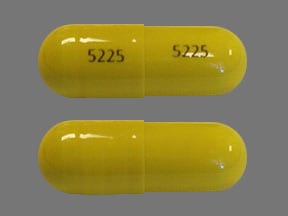Dosage Forms
Excipient information presented when available (limited, particularly for generics); consult specific product labeling.
Capsule, Oral, as hydrochloride:
Generic: 250 mg, 500 mg
Pharmacology
Mechanism of Action
Inhibits bacterial protein synthesis by binding with the 30S and possibly the 50S ribosomal subunit(s) of susceptible bacteria; may also cause alterations in the cytoplasmic membrane
Pharmacokinetics/Pharmacodynamics
Absorption
Oral: 77% to 88% (Agwuh 2006); IM: Poor, with less than 60% of dose absorbed
Distribution
Widely distributed to most body fluids and tissues including ascitic, synovial and pleural fluids; bronchial secretions; poor penetration into CSF
Excretion
Urine (30%); feces (20% to 60%) (Agwuh 2006)
Time to Peak
Serum: Oral: 2 to 4 hours (Agwuh 2006)
Half-Life Elimination
6 to 11 hours (Agwuh 2006)
Protein Binding
55% to 64% (Agwuh 2006)
Use in Specific Populations
Special Populations: Renal Function Impairment
Because renal Cl is by glomerular filtration, excretion is significantly affected by the state of renal function.
Use: Labeled Indications
Acute intestinal amebiasis: Adjunctive therapy in acute intestinal amebiasis caused by Entamoeba histolytica.
Acne: Adjunctive therapy for the treatment of severe acne.
Actinomycosis: Treatment of actinomycosis caused by Actinomyces species when penicillin is contraindicated.
Anthrax: Treatment of anthrax due to Bacillus anthracis when penicillin is contraindicated.
Campylobacter: Treatment of infections caused by Campylobacter fetus.
Cholera: Treatment of cholera caused by Vibrio cholerae.
Clostridium: Treatment of infections caused by Clostridium spp. when penicillin is contraindicated.
Gram-negative infections: Treatment of infections caused by Escherichia coli, Enterobacter aerogenes, Shigella spp., Acinetobacter spp., Klebsiella spp., and Bacteroides spp.
Listeriosis: Treatment of listeriosis due to Listeria monocytogenes when penicillin is contraindicated.
Ophthalmic infections: Treatment of inclusion conjunctivitis or trachoma caused by Chlamydia trachomatis.
Relapsing fever: Treatment of relapsing fever due to Borrelia spp.
Respiratory tract infection: Treatment of respiratory tract infections caused by Haemophilus influenzae (upper respiratory tract only), Klebsiella spp. (lower respiratory tract only), Mycoplasma pneumoniae (lower respiratory tract only), Streptococcus pneumoniae, or Streptococcus pyogenes.
Rickettsial infections: Treatment of Rocky Mountain spotted fever, typhus group infections, Q fever, and rickettsialpox caused by Rickettsiae.
Sexually transmitted diseases: Treatment of lymphogranuloma venereum or uncomplicated urethral, endocervical, or rectal infections caused by C. trachomatis; chancroid caused by Haemophilus ducreyi; granuloma inguinale (donovanosis) caused by Klebsiella granulomatis; syphilis caused by Treponema pallidum, when penicillin is contraindicated.
Limitations of use: Tetracycline is not a recommended alternative for uncomplicated gonorrhea according to the Centers for Disease Control and Prevention (CDC) sexually transmitted diseases guidelines (CDC [Workowski 2015]).
Skin and skin structure infections: Treatment of skin and skin structure infections caused by Staphylococcus aureus or S. pyogenes.
Urinary tract infections: Treatment of urinary tract infections caused by susceptible gram-negative organisms (eg, E. coli, Klebsiella spp.).
Vincent infection: Treatment of Vincent infection caused by Fusobacterium fusiforme when penicillin is contraindicated.
Yaws: Treatment of yaws caused by Treponema pertenue when penicillin is contraindicated.
Zoonotic infections: Treatment of psittacosis (ornithosis) due to Chlamydophila psittaci; plague due to Yersinia pestis; tularemia due to Francisella tularensis; brucellosis due to Brucella spp. (in conjunction with an aminoglycoside); bartonellosis due to Bartonella bacilliformis.
Use: Off Label
Helicobacter pylori eradicationyes
Based on the American College of Gastroenterology Clinical Guideline for the Treatment of Helicobacter pylori infection, tetracycline is an effective and recommended component of a multiple-drug regimen for the treatment of this condition.
Malariayes
Based on the Centers for Disease Control and Prevention (CDC) Treatment of Malaria (Guidelines for Clinicians), tetracycline given in combination with quinidine (severe) or quinine (uncomplicated) for the treatment of malaria is effective and recommended in the management of this condition.
Periodontitis associated with presence of Actinobacillus actinomycetemcomitansc
Clinical experience suggests the utility of tetracycline in periodontitis associated with presence of Actinobacillus actinomycetemcomitans Seymour 1995. Additional data may be necessary to further define the role of tetracycline in this condition.
Contraindications
Hypersensitivity to any of the tetracyclines or any component of the formulation.
Canadian labeling: Additional contraindications (not in US labeling): Severe liver disease; severe renal disease; use in children <12 years of age for therapy of common infections or conditions where bactericidal effect is essential (bacterial endocarditis); surgical prophylaxis; pregnancy; breastfeeding.
Dosage and Administration
Dosing: Adult
Usual dosage range: Oral: 250 to 500 mg every 6 to 12 hours
Acne: Oral: Initial dose: 1 g daily in divided doses; reduce gradually to 125 to 500 mg/day once improvement is noted (alternate day or intermittent therapy may be adequate in some patients). Note: The shortest possible duration should be used to minimize development of bacterial resistance; re-evaluate at 3 to 4 months (AAD [Zaenglein 2016])
Helicobacter pylori eradication (off-label use): Oral:
American College of Gastroenterology guidelines (Chey 2007; Chey 2017):
Bismuth quadruple regimen: 500 mg 4 times daily, in combination with standard-dose proton pump inhibitor twice daily, metronidazole 250 mg 4 times daily or 500 mg 3 or 4 times daily, and either bismuth subcitrate 120 to 300 mg 4 times daily or bismuth subsalicylate 300 mg 4 times daily; continue regimen for 10 to 14 days.
Malaria, severe, treatment (off-label use): Oral: 250 mg 4 times daily for 7 days with quinidine gluconate. Note: Quinidine gluconate duration is region specific; consult CDC for current recommendations (CDC 2013).
Malaria, uncomplicated, treatment (off-label use): Oral: 250 mg 4 times daily for 7 days with quinine sulfate. Note: Quinine sulfate duration is region specific; consult CDC for current recommendations (CDC 2013).
Periodontitis (off-label use): Oral: 250 mg every 6 hours until improvement (usually 10 days)
Syphilis, penicillin-allergic patients: Note: Data to support the use of alternatives to penicillin are limited in primary and secondary syphilis and are not well documented in the treatment of latent syphilis (CDC [Workowski 2015])
Early syphilis (primary or secondary infection): 500 mg 4 times daily for 14 days.
Latent syphilis (late or of unknown duration): 500 mg 4 times daily for 28 days.
Tularemia (mild to moderate): Oral: 500 mg 4 times daily for at least 14 days (IDSA [Stevens 2014])
Vibrio cholerae: Oral: 500 mg 4 times daily for 3 days (Seas 1996)
Dosing: Geriatric
Refer to adult dosing.
Dosing: Pediatric
General dosing, susceptible infection: Children ≥8 years and Adolescents: Oral: 25 to 50 mg/kg/day in divided doses every 6 hours
Acne: Children ≥8 years and Adolescents: Oral: 500 mg/dose twice daily (Eichenfield 2013)
Malaria, treatment: Note: Use in combination with other antimalarial agents:
Uncomplicated infection (P. falciparum, P. vivax or unknown species), chloroquine-resistant or unknown resistance: Children ≥8 years and Adolescents:
Non-HIV-exposed/-positive: Oral: 6.25 mg/kg/dose every 6 hours for 7 days; maximum dose: 250 mg/dose (CDC 2013)
HIV-exposed/-positive: Oral: 6 to 12.5 mg/kg/dose every 6 hours for 7 days; maximum dose: 500 mg/dose (HHS [OI pediatric 2013])
Severe infection: Note: Use in combination with other antimalarial agents; Children ≥8 years and Adolescents:
Non-HIV-exposed/-positive: Oral: 6.25 mg/kg/dose every 6 hours for 7 days; maximum dose: 250 mg/dose (CDC 2013)
HIV-exposed/-positive: Oral: 6 to 12.5 mg/kg/dose every 6 hours for 7 days; maximum dose: 500 mg/dose (HHS [OI pediatric 2013])
Syphilis, penicillin-allergic patients: Note: Data to support the use of alternatives to penicillin are limited in primary and secondary syphilis and are not well documented in the treatment of latent syphilis (CDC [Workowski 2015]): Adolescents: Oral:
Early syphilis (primary or secondary infection): 500 mg/dose 4 times daily for 14 days
Latent syphilis (late or of unknown duration): 500 mg/dose 4 times daily for 28 days
Extemporaneously Prepared
A 25 mg/mL oral suspension may be made using capsules. Empty the contents of six 500 mg capsules into mortar. Add a small amount (~20 mL) of a 1:1 mixture of Ora-Sweet® and Ora-Plus® and mix to a uniform paste; mix while adding the vehicle in geometric proportions to almost 120 mL; transfer to a calibrated bottle, rinse mortar with vehicle, and add quantity of vehicle sufficient to make 120 mL. Label "shake well" and "refrigerate". Stable 28 days refrigerated.
Nahata MC, Pai VB, and Hipple TF, Pediatric Drug Formulations, 5th ed, Cincinnati, OH: Harvey Whitney Books Co, 2004.
Administration
Administer on an empty stomach (ie, 1 hour prior to, or 2 hours after meals) to increase total absorption and with adequate amount of fluid to reduce risk of esophageal irritation and ulceration. Administer at least 1 to 2 hours prior to, or 4 hours after antacid because aluminum and magnesium cations may chelate with tetracycline and reduce its total absorption.
Dietary Considerations
Take on an empty stomach (ie, 1 hour prior to, or 2 hours after meals). Take at least 1-2 hours prior to, or 4 hours after antacid.
Storage
Store at 20°C to 25°C (68°F to 77°F); protect from light. Use of outdated tetracyclines has caused a Fanconi-like syndrome (nausea, vomiting, acidosis, proteinuria, glycosuria, aminoaciduria, polydipsia, polyuria, hypokalemia).
Tetracycline (Systemic) Images
Drug Interactions
Aminolevulinic Acid (Systemic): Photosensitizing Agents may enhance the photosensitizing effect of Aminolevulinic Acid (Systemic). Avoid combination
Aminolevulinic Acid (Topical): Photosensitizing Agents may enhance the photosensitizing effect of Aminolevulinic Acid (Topical). Monitor therapy
Antacids: May decrease the absorption of Tetracyclines. Management: Separate administration of antacids and oral tetracycline derivatives by several hours when possible to minimize the extent of this potential interaction. Consider therapy modification
Atovaquone: Tetracycline (Systemic) may decrease the serum concentration of Atovaquone. Monitor therapy
BCG (Intravesical): Antibiotics may diminish the therapeutic effect of BCG (Intravesical). Avoid combination
BCG Vaccine (Immunization): Antibiotics may diminish the therapeutic effect of BCG Vaccine (Immunization). Monitor therapy
Bile Acid Sequestrants: May decrease the absorption of Tetracyclines. Consider therapy modification
Bismuth Subcitrate: May decrease the serum concentration of Tetracyclines. Management: Avoid administration of oral tetracyclines within 30 minutes of bismuth subcitrate administration. This is of questionable significance for at least some regimens intended to treat H. pylori infections. Consider therapy modification
Bismuth Subsalicylate: May decrease the serum concentration of Tetracyclines. Management: Consider dosing tetracyclines 2 hours before or 6 hours after bismuth. The need to separate doses during Helicobacter pylori eradication regimens is questionable. Consider therapy modification
Bosentan: May decrease the serum concentration of CYP3A4 Substrates (High risk with Inducers). Monitor therapy
Calcium Salts: May decrease the serum concentration of Tetracyclines. Management: If coadministration of oral calcium with oral tetracyclines can not be avoided, consider separating administration of each agent by several hours. Consider therapy modification
Cholera Vaccine: Antibiotics may diminish the therapeutic effect of Cholera Vaccine. Management: Avoid cholera vaccine in patients receiving systemic antibiotics, and within 14 days following the use of oral or parenteral antibiotics. Avoid combination
CYP3A4 Inducers (Moderate): May decrease the serum concentration of CYP3A4 Substrates (High risk with Inducers). Monitor therapy
CYP3A4 Inducers (Strong): May increase the metabolism of CYP3A4 Substrates (High risk with Inducers). Management: Consider an alternative for one of the interacting drugs. Some combinations may be specifically contraindicated. Consult appropriate manufacturer labeling. Consider therapy modification
Dabrafenib: May decrease the serum concentration of CYP3A4 Substrates (High risk with Inducers). Management: Seek alternatives to the CYP3A4 substrate when possible. If concomitant therapy cannot be avoided, monitor clinical effects of the substrate closely (particularly therapeutic effects). Consider therapy modification
Deferasirox: May decrease the serum concentration of CYP3A4 Substrates (High risk with Inducers). Monitor therapy
Enzalutamide: May decrease the serum concentration of CYP3A4 Substrates (High risk with Inducers). Management: Concurrent use of enzalutamide with CYP3A4 substrates that have a narrow therapeutic index should be avoided. Use of enzalutamide and any other CYP3A4 substrate should be performed with caution and close monitoring. Consider therapy modification
Erdafitinib: May decrease the serum concentration of CYP3A4 Substrates (High risk with Inducers). Monitor therapy
Iron Preparations: Tetracyclines may decrease the absorption of Iron Preparations. Iron Preparations may decrease the serum concentration of Tetracyclines. Management: Avoid this combination if possible. Administer oral iron preparations at least 2 hours before, or 4 hours after, the dose of the oral tetracycline derivative. Monitor for decreased therapeutic effect of oral tetracycline derivatives. Exceptions: Ferric Carboxymaltose; Ferric Derisomaltose; Ferric Gluconate; Ferric Hydroxide Polymaltose Complex; Ferric Pyrophosphate Citrate; Ferumoxytol; Iron Dextran Complex; Iron Sucrose. Consider therapy modification
Ivosidenib: May decrease the serum concentration of CYP3A4 Substrates (High risk with Inducers). Monitor therapy
Lactobacillus and Estriol: Antibiotics may diminish the therapeutic effect of Lactobacillus and Estriol. Monitor therapy
Lanthanum: May decrease the serum concentration of Tetracyclines. Management: Administer oral tetracycline antibiotics at least two hours before or after lanthanum. Consider therapy modification
Lorlatinib: May decrease the serum concentration of CYP3A4 Substrates (High risk with Inducers). Management: Avoid concurrent use of lorlatinib with any CYP3A4 substrates for which a minimal decrease in serum concentrations of the CYP3A4 substrate could lead to therapeutic failure and serious clinical consequences. Consider therapy modification
Magnesium Dimecrotate: May interact via an unknown mechanism with Tetracyclines. Monitor therapy
Magnesium Salts: May decrease the absorption of Tetracyclines. Only applicable to oral preparations of each agent. Consider therapy modification
Mecamylamine: Tetracyclines may enhance the neuromuscular-blocking effect of Mecamylamine. Avoid combination
Methoxyflurane: Tetracyclines may enhance the nephrotoxic effect of Methoxyflurane. Avoid combination
Mipomersen: Tetracyclines may enhance the hepatotoxic effect of Mipomersen. Monitor therapy
Mitotane: May decrease the serum concentration of CYP3A4 Substrates (High risk with Inducers). Management: Doses of CYP3A4 substrates may need to be adjusted substantially when used in patients being treated with mitotane. Consider therapy modification
Multivitamins/Minerals (with ADEK, Folate, Iron): May decrease the serum concentration of Tetracyclines. Management: If coadministration of a polyvalent cation-containing multivitamin with oral tetracyclines can not be avoided, separate administration of each agent by several hours. Consider therapy modification
Multivitamins/Minerals (with AE, No Iron): May decrease the serum concentration of Tetracyclines. Management: If coadministration of a polyvalent cation-containing multivitamin with oral tetracyclines can not be avoided, separate administration of each agent by several hours. Consider therapy modification
Neuromuscular-Blocking Agents: Tetracyclines may enhance the neuromuscular-blocking effect of Neuromuscular-Blocking Agents. Monitor therapy
Penicillins: Tetracyclines may diminish the therapeutic effect of Penicillins. Monitor therapy
Porfimer: Photosensitizing Agents may enhance the photosensitizing effect of Porfimer. Monitor therapy
Quinapril: May decrease the serum concentration of Tetracyclines. Management: Separate doses of quinapril and oral tetracycline derivatives by at least 2 hours in order to reduce the risk of interaction. Monitor for reduced efficacy of the tetracycline if these products are used concomitantly. Consider therapy modification
QuiNINE: Tetracycline (Systemic) may increase the serum concentration of QuiNINE. Monitor therapy
Retinoic Acid Derivatives: Tetracyclines may enhance the adverse/toxic effect of Retinoic Acid Derivatives. The development of pseudotumor cerebri is of particular concern. Exceptions: Adapalene; Bexarotene (Topical); Tretinoin (Topical). Avoid combination
Sarilumab: May decrease the serum concentration of CYP3A4 Substrates (High risk with Inducers). Monitor therapy
Siltuximab: May decrease the serum concentration of CYP3A4 Substrates (High risk with Inducers). Monitor therapy
Sodium Picosulfate: Antibiotics may diminish the therapeutic effect of Sodium Picosulfate. Management: Consider using an alternative product for bowel cleansing prior to a colonoscopy in patients who have recently used or are concurrently using an antibiotic. Consider therapy modification
Strontium Ranelate: May decrease the serum concentration of Tetracyclines. Management: In order to minimize any potential impact of strontium ranelate on tetracycline antibiotic concentrations, it is recommended that strontium ranelate treatment be interrupted during tetracycline therapy. Avoid combination
Sucralfate: May decrease the absorption of Tetracyclines. Management: Administer most tetracycline derivatives at least 2 hours prior to sucralfate in order to minimize the impact of this interaction. Administer oral omadacycline 4 hours prior to sucralfate. Consider therapy modification
Sucroferric Oxyhydroxide: May decrease the serum concentration of Tetracyclines. Management: Administer oral/enteral doxycycline at least 1 hour before sucroferric oxyhydroxide. Specific dose separation guidelines for other tetracyclines are not presently available. No interaction is anticipated with parenteral administration of tetracyclines. Consider therapy modification
Tocilizumab: May decrease the serum concentration of CYP3A4 Substrates (High risk with Inducers). Monitor therapy
Typhoid Vaccine: Antibiotics may diminish the therapeutic effect of Typhoid Vaccine. Only the live attenuated Ty21a strain is affected. Management: Vaccination with live attenuated typhoid vaccine (Ty21a) should be avoided in patients being treated with systemic antibacterial agents. Use of this vaccine should be postponed until at least 3 days after cessation of antibacterial agents. Consider therapy modification
Verteporfin: Photosensitizing Agents may enhance the photosensitizing effect of Verteporfin. Monitor therapy
Vitamin K Antagonists (eg, warfarin): Tetracyclines may enhance the anticoagulant effect of Vitamin K Antagonists. Monitor therapy
Zinc Salts: May decrease the absorption of Tetracyclines. Only a concern when both products are administered orally. Management: Consider doxycycline as a noninteracting tetracycline derivative. Separate dose administration of oral tetracycline derivative and oral zinc salts by at least 2 hours to minimize interaction. Exceptions: Zinc Chloride. Consider therapy modification
Adverse Reactions
Frequency not defined:
Cardiovascular: Pericarditis
Central nervous system: Bulging fontanel, idiopathic intracranial hypertension
Dermatologic: Erythematous rash, maculopapular rash, skin photosensitivity, urticaria
Endocrine & metabolic: Growth retardation (fibula)
Gastrointestinal: Anorexia, diarrhea, dysphagia, enterocolitis, epigastric distress, glossitis, melanoglossia, nausea, vomiting
Genitourinary: Inflammatory anogenital lesion (with monilial overgrowth)
Hematologic & oncologic: Henoch-Schonlein purpura
Hepatic: Hepatic failure, hepatotoxicity
Hypersensitivity: Anaphylaxis, angioedema, hypersensitivity reaction
Immunologic: Serum sickness-like reaction
Neuromuscular & skeletal: Exacerbation of systemic lupus erythematosus
Postmarketing: Discoloration of permanent tooth, dysgeusia (Syed 2016), enamel hypoplasia (infants, young children), eosinophilia, esophageal ulcer, esophagitis, exfoliative dermatitis, hemolytic anemia, immune thrombocytopenia, increased blood urea nitrogen, lupus-like syndrome (Lee 2013), microscopic thyroid discoloration, nail discoloration, neutropenia, onycholysis, staining of tooth (infants, young children), thrombocytopenia
Warnings/Precautions
Concerns related to adverse effects:
- Increased BUN: May be associated with increases in serum urea nitrogen (BUN) secondary to antianabolic effects; use caution in patients with renal impairment.
- Intracranial hypertension (eg, pseudotumor cerebri): Intracranial hypertension (headache, blurred vision, diplopia, vision loss, and/or papilledema) has been associated with use. Women of childbearing age who are overweight or have a history of intracranial hypertension are at greater risk. Concomitant use of isotretinoin (known to cause pseudotumor cerebri [PTC]) and tetracycline should be avoided. Intracranial hypertension typically resolves after discontinuation of treatment; however, permanent visual loss is possible. If visual symptoms develop during treatment, prompt ophthalmologic evaluation is warranted. Intracranial pressure can remain elevated for weeks after drug discontinuation; monitor patients until they stabilize.
- Photosensitivity: May cause photosensitivity; discontinue if skin erythema occurs. Use skin protection and avoid prolonged exposure to sunlight; do not use tanning equipment.
- Superinfection: Prolonged use may result in fungal or bacterial superinfection, including Clostridioides (formerly Clostridium) difficile-associated diarrhea (CDAD) and pseudomembranous colitis; CDAD has been observed >2 months postantibiotic treatment.
Disease-related concerns:
- Hepatic impairment: Hepatotoxicity has been reported rarely; risk may be increased in patients with preexisting hepatic or renal impairment.
- Renal impairment: Use with caution in patients with renal impairment; dosage adjustment recommended.
Special populations:
- Pediatric: May cause tissue hyperpigmentation, enamel hypoplasia, or permanent tooth discoloration; use of tetracyclines should be avoided during tooth development (children <8 years of age) unless other drugs are not likely to be effective or are contraindicated.
- Pregnancy: Do not use during pregnancy. In addition to affecting tooth development, tetracycline use has been associated with retardation of skeletal development and reduced bone growth.
Other warnings/precautions:
- Appropriate use: Acne: The American Academy of Dermatology acne guidelines recommend tetracycline as adjunctive treatment for moderate and severe acne and forms of inflammatory acne that are resistant to topical treatments. Concomitant topical therapy with benzoyl peroxide or a retinoid should be administered with systemic antibiotic therapy (eg, tetracycline) and continued for maintenance after antibiotic course is completed (AAD [Zaenglein 2016]).
Monitoring Parameters
Renal, hepatic, and hematologic function test, temperature, WBC, cultures and sensitivity, appetite, mental status
Pregnancy
Pregnancy Risk Factor
D
Pregnancy Considerations
Tetracycline crosses the placenta (Leblanc 1967). Tetracyclines accumulate in developing teeth and long tubular bones (Mylonas 2011). Permanent discoloration of teeth (yellow, gray, brown) can occur following in utero exposure and is more likely to occur following long-term or repeated exposure. The pharmacokinetics of tetracycline are not altered in pregnant patients with normal renal function (Whalley 1966; Whalley 1970). Hepatic toxicity during pregnancy, potentially associated with tetracycline use, has been reported. Pregnant women with renal disease may be more likely to develop hepatic failure with tetracycline use.
As a class, tetracyclines are generally considered second-line antibiotics in pregnant women and their use should be avoided (Mylonas 2011). Many guidelines consider use of tetracycline to be contraindicated during pregnancy, or to be a relative contraindication in pregnant women if other agents are available and appropriate for use (Anderson 2013; CDC 2011; HHS [OI adult 2015]; Stevens 2014; Workowski [CDC 2015]; Wormser 2006). When systemic antibiotics are needed for dermatologic conditions in pregnant women, other agents are preferred (Kong 2013; Murase 2014).
Patient Education
What is this drug used for?
- It is used to treat bacterial infections.
- It is used to treat pimples (acne).
Frequently reported side effects of this drug
- Lack of appetite
- Diarrhea
Other side effects of this drug: Talk with your doctor right away if you have any of these signs of:
- Liver problems like dark urine, feeling tired, lack of appetite, nausea, abdominal pain, light-colored stools, vomiting, or yellow skin or eyes
- Chills
- Sore throat
- Dysphagia
- Bruising
- Bleeding
- Severe loss of strength and energy
- Severe headache
- Severe nausea
- Severe vomiting
- Joint pain
- Vaginal pain, itching, and discharge
- Blindness
- Blurred vision
- Double vision
- Clostridium difficile (C. diff)-associated diarrhea like stomach pain or cramps, very loose or watery stools, or bloody stools.
- Signs of a significant reaction like wheezing; chest tightness; fever; itching; bad cough; blue skin color; seizures; or swelling of face, lips, tongue, or throat.
Note: This is not a comprehensive list of all side effects. Talk to your doctor if you have questions.
Consumer Information Use and Disclaimer: This information should not be used to decide whether or not to take this medicine or any other medicine. Only the healthcare provider has the knowledge and training to decide which medicines are right for a specific patient. This information does not endorse any medicine as safe, effective, or approved for treating any patient or health condition. This is only a brief summary of general information about this medicine. It does NOT include all information about the possible uses, directions, warnings, precautions, interactions, adverse effects, or risks that may apply to this medicine. This information is not specific medical advice and does not replace information you receive from the healthcare provider. You must talk with the healthcare provider for complete information about the risks and benefits of using this medicine.










